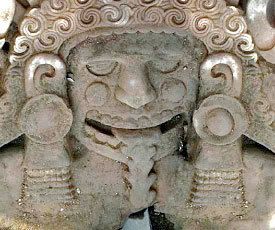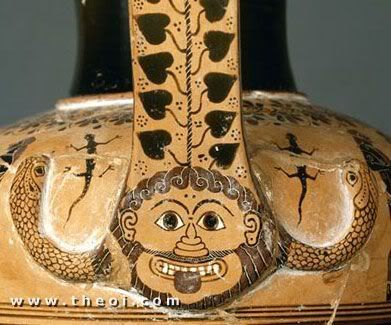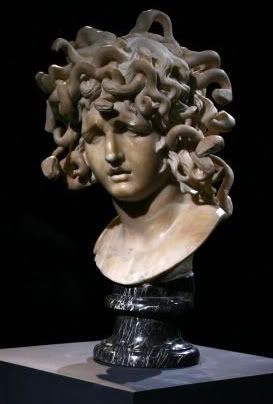
Note Shamash has a ‘crown of thorns’ or rays of light symbolizing his connection to sun light, as well as the eagles which are akin to winged sun-disc symbols which basically mean that the sun is part of the above and is carried aloft through the heavens. If you take a look at the Medusa picture from the last post you will notice wings by her head. And as already stated, she was basically a mask, or a head, with a body later appended. Therefore her head is apparently some object which flys through the heavens, and/or symbolizes a force connected with the above.

Check out this picture of Medusa. Notice that she is usually depicted as very manly with lots of facial hair and bigger legs than male figures. She is always wide-eyed with her mouth open and is sticking her tongue out. Most of the time she is shown with 4 wings. A few sculptures and lots of more recent Medusa inspired artwork shows a young attractive woman, as the mythology sometimes has her as being young and attractive before Athena punished her with uglyness and snake hair as punishment for being raped by Poseidon in Athena’s temple. That would piss anyone off: get raped and then get punished for it! Many of these traits are held by various other gods and demigods around the world. Here are a few which I found:

This is Tlaltecuhtli,
... a chthonic sea monster who dwelled in the ocean after the fourth Great Flood, an embodiment of the raging chaos before creation. Quetzalcoatl and Tezcatlipoca, in the form of serpents, tore her in half, throwing half upwards to create the sky and stars and leaving the other half to become the land of the earth. She remained alive, however, and demanded human blood.This deity has a male name, but is depicted as a female, usually in a birthing position. Tlaltecuhtli has some great characteristics which I think are very much connected to the archetypal symbology of Medusa. Medusa is a woman with very manly features, quite similar to Tlaltecuhtli as a woman with a man's name. Another thing that stands out is that Tlaltecuhtli was torn in half by two serpents.

In this picture of Medusa, which I saved to my computer as a image file named "Gorgon_and_two_snakes_pulling_her_apart," we can see the two snakes usually depicted flanking Medusa's head; and damned if it doesn't look like they're pulling her apart. Tlaltecuhtli:
...was thought to swallow the sun every night and regurgitate it back out in the morning. She was also thought to swallow the hearts of victims sacrificed to her, so it was common to carve images of her on the bottom of stone boxes in which the hearts and blood of sacrificial victims where placed after being ripped from their bodies.She has interesting vampiritic life-sucking traits which extends to the swallowing of the life-giving sun its self. She is also equivalent of Tiamat, a "monstrous embodiment of primordial chaos," and "personified as a goddess," as well as being seen as the constellation Cetus, a sea-monster.

Here is a Tzitzimitl, who represents "skeletal female figures wearing skirts often with skull and crossbone designs." There's no need to explain what a skull & crossed bones represents, as the Tzitzimitl are ancestor spirits who were honored on Las Dias de Los Muertos, the Day of the Dead. They were "worshipped by midwives and parturient women," which parellels Tlaltecuhtli who is usually depicted in the position of giving birth.
The Tzitzimimeh were also associated with the stars and especially the stars that can be seen around the sun during a solar eclipse. This was interpreted as the Tzitzimimeh attacking the sun, this caused the belief that during a solar eclipse, the tzitzimime would descend to the earth and devour human beings.
Immanuel Velikovsky in his much maligned work Worlds in Collision suggests that Venus may have at one time (in human hisory) been a comet which was then trapped by the sun's gravity. He asserts that the old names for the planet meant "bearded" or "having a mane of hair," which are a result of it's cometary tail; and as such was associated with dragons/serpents. Regardless of how Venus came to be, Velikovsky connects the serpent to the eclipse:
In fact, no stretch at all is needed to establish the equation of flowing mane and serpent-dragon or chaos monster. The Aztec Tzonte-Mocque, identified with the planet Venus, and whose name Brasseur translated as "mane," was depicted as a dragon-like monster approaching the Earth in periods of eclipse or universal darkness. A counterpart of this chaos- or eclipse-demon is the Aztec Tzitzimitl, with "madly disheveled hair," descending upon a darkened world.The phrase "madly disheveled hair" sounds quite reminicent of Medusa's slithering locks.

The MEdusa Touch is continued in Part 3.

3 comments:
Well that's all for tonight. I'll try to get it all out in one or two more parts, but I'm currently playing an addictive online game and might not get it all done as quickly as I should ;)
Awesome article. Interesting material about Shamash. There's sometimes a confusion/transferal between the figures of John the Baptist and John the Evangelist, especially in esoteric circles like Freemasonry. John the Evangelist is of course represented by the Eagle.
An earthly incarnation of the Sunny disposition is Shamshun , aka SAMSON, pusher apart of twin pillars and other acts of wholesale destructiva
Post a Comment